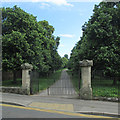1
Elm Avenue at Cranmer Street
At this scale the gateposts look to be the same, but a closer look reveals that each is dedicated to a different tree or plant.
Elm Avenue and the Chase capitals http://www.geograph.org.uk/search.php?i=5558919&displayclass=slide
Image: © Alan Murray-Rust
Taken: 8 Mar 2009
0.02 miles
2
Elm Avenue, Nottingham - upper section
The 1845 Enclosure Act set aside 130 acres of land to the north and east of Nottingham city centre as public open space, comprising Queen's Walk, Queen's Walk Park, Victoria Park, Robin Hood Chase, Corporation Oaks, St Ann's Hill, Elm Avenue, the Arboretum, the General Cemetery, Waterloo Promenade, Church Cemetery, and The Forest.
Image: © Stephen Craven
Taken: 18 Jan 2020
0.03 miles
3
Closed school
The Elms school was closed in 2009. The house in the foreground was presumably for the caretaker.
Image: © Michael Dibb
Taken: 31 Mar 2017
0.03 miles
4
Closed school on Cranmer Street
This was formerly the Elms Primary School (the building in the foreground was probably just the caretaker's house; the main school buildings
Image are to the rear).
Image: © Stephen Craven
Taken: 18 Jan 2020
0.03 miles
5
Gordon House
Now a hall of residence for Nottingham Trent University, it was formerly the Nottingham Gordon Home for Boys.
Image: © Alan Murray-Rust
Taken: 8 Mar 2009
0.03 miles
6
Up Elm Avenue from Cranmer Street
In 1833 a Select Committee on Public Walks recommended the creation of “properly regulated” public walks for the “middle and humbler classes” in order to improve “their cleanliness, neatness and personal appearance” and provide a venue for a man to show off his wife and well-behaved children. Such walks were seen as an alternative to the “drinking shops, where, in short-lived excitement, they may forget their toil, but where they waste the means of their families and too often destroy their health”.
It became possible to implement these recommendations after the 1845 Enclosure Act, and by 1852 walks and other green spaces had been established in an arc north of the town centre, from Robin Hood Chase in the east, along Corporation Oaks and Elm Avenue to the Arboretum and the General Cemetery. The Forest recreation ground was also established.
A journalist then wrote that “Nottingham might vie with any town in England for its well-grown and well-dressed women of the operative classes who on Sunday throng the park and public walks.”
(All of this information comes from “The transformation of green space in old and new Nottingham” in Volume 118 of the Transactions of the Thoroton Society.)
Image: © John Sutton
Taken: 6 Jul 2015
0.03 miles
7
Nottingham - NG3
The driveway that leads to the now defunct Elms Nursery School, Cranmer Street, albeit that this entrance is off Goldswong Terrace. This establishment and its partner institution, The Elms Primary School, Cranmer Street were closed on 31st August 2008.
Image: © David Hallam-Jones
Taken: 20 Apr 2012
0.03 miles
8
Nottingham - NG1
The Elm Avenue/Bellevue (covered reservoir) section of a longer footpath that runs from Huntingdon Street - where the A60 enters the city centre - and Woodborough Road. From a hot air balloon the observer would probably see a rosette-shaped structure below her/him with the footpaths projecting from the circular part the rosette (i.e. the covered reservoir) with the grass-edged footpaths forming the rosette's ribbons.
Image: © David Hallam-Jones
Taken: 20 Apr 2012
0.03 miles
9
Nottingham - NG3
The main entrance of the now defunct Elms Primary & Nursery School, Cranmer Street. The school was built in the 1940s and it closed, due to a falling roll, on 31 August 2008. Although it is difficult to tell from this particular picture, the block ahead is constructed in art deco style. The east wing on the right-hand margin of the photo however, lacks as much architectural importance. At present, in 2017, consideration is being given to the partial redevelopment of the site, with talk of the Cranmer Street-facing block being demolished.
Image: © David Hallam-Jones
Taken: 20 Apr 2012
0.03 miles
10
The Elms Primary School
A distinctive design in modernist style. I would guessthat it dates to shortly after the second world war.
Image: © Alan Murray-Rust
Taken: 8 Mar 2009
0.03 miles











